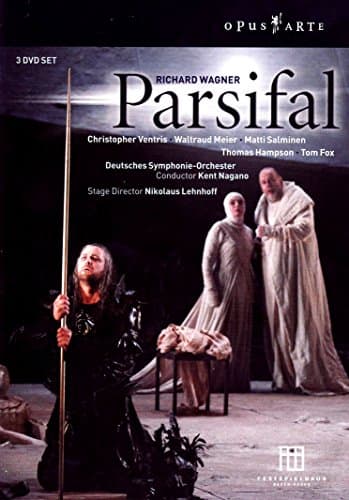
Wagner/Syberberg, Parsifal
Wagner/Syberberg, Parsifal
When you purchase through links on our site, we may earn an affiliate commission. Here's how it works.

User Reviews
Wagner/syberberg, Parsifal - The Best Opera Film E
Wagner/Syberberg, Parsifal - The best opera film ever made? How is this possible? The notion of a full-length feature of Wagner's last and strangest opus is unsettling enough. Add to it the title role taken by a man AND a woman, extensive use of puppetry, never mind a two-story plaster replica of Wagner's death mask that whirls, tilts, bends, splits open, and even disgorges Grail knights (among any number of other things) well, the mind boggles.
Opera purists have been known to foam at the mouth, eyes turned back in their heads, at the very mention of this 1982 motion picture by the darling of German avante guarde cinema whose previous effort was an 8-hour marathon entitled "Our Hitler." Nor does Syberberg disappoint, his Wagner adaptation stuffed tight with ideas guaranteed to disturb anyone whose notion of Monsalvat ends at the Sienna Cathedral. Not that, over the last decades, opera has been any stranger to surrealism. Yet some especially potent alchemy enervates this particular instance.
For one thing, Syberberg's visual style, inherently "unreal," ipso facto, trumps the music-on-film problem. His first shot, a stage designer's model of a traditional Grail Hall before a rank pool awash in snapshots and a fallen swan, leaves no doubt this enterprise is deliberately "artificial." Yet the wealth of signs - a bona fide corpse huge beside a tiny paper mach building, actual photographs but a fake pond, Wagnerian imagery leavened with 20th century - pushes minds (those in use, at least) towards bewilderingly rich associations, ideas as meaningful as their presentation is fantastical. This is not the fleshly but the conceptual world. "Parsifal," after all, is all about valuing the mental over the physical state.
The film's real triumph, though, is Syberberg's cinematic technique, that simultaneously debunks and validates Wagner, theater, mythology, history, and a host of other themes. The audience floats in an indefinable space beyond theater AND cinema, a landscape with boundaries set by physical trappings of stage, film, and history yet whose ultimate shape mysteriously defies quantification. The libretto is taken at its literal word: time and space do indeed become one.
This is not an "easy" film. It presents the entire massive score, filling its every moment with cascades of images designed to engage but also tax a viewer's mental powers. Only multiple viewings can ferret out its insights, making it ideal for DVD home video. For those willing to expand their universe, to plunge into the deepest lodes of human thought, this is a must-see experience.
Q&A
There are no questions yet.